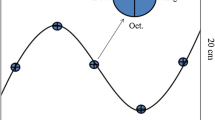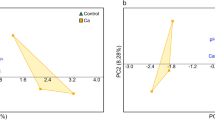Abstract
The ability of an ecosystem to withstand serious disturbances may depend in part on the diversity of the system, with soil microbiological communities being coupled to their associated vegetation. The main objectives of the present study were (1) to determine the association between soil microbial diversity, abundance, and activities with diversity and sustainability of remediated mining-damaged ecosystems in Northern Ontario, and (2) to assess the effects of dolomitic lime applications on aboveground and belowground biodiversity and community structures. Results revealed that liming increases soil pH, cation exchange capacity (CEC), forest tree species diversity and abundance, and the overall ecosystem health even 25 to 35 years after dolomite applications. The mean Shannon index value was significantly higher in limed compared to unlimed sites. Tree species richness was 4.0, 6.0, and 7.7 for unlimed, limed, and reference sites, respectively. Overall, the mean health index revealed a significant improvement in population health in limed sites (index score = 7) compared to unlimed areas (index score = 4). Soil microbial biomass and respiration were also increased by liming. Surprisingly, the main component of soil microbial biomass in limed, unlimed, and reference sites within the vicinity of the restored lands was bacteria (mostly Gram (−). Significant difference was also observed between limed, unlimed, and reference sites for arbuscular mycorrhizal fungi, Gram (−) bacteria, Gram (+) bacteria, anaerobe, and actinomycetes abundance. The ratios between fungi and bacteria and among other phospholipid fatty acid (PLFA) measures were extremely low suggesting that the targeted region is still under environmental stress. No apparent associations among soil microbial biomass, soil respiration, and forest plant diversity or abundance were observed. Soil pH levels and organic matter amounts and quality appear to be the main factors affecting these parameters. Molecular analysis of main tree species within the impacted region revealed no change in genetic variation among plant populations on either limed or unlimed lands contaminated with metals over two generations.






Similar content being viewed by others
References
Amiro, B. D., & Courtin, G. M. (1981). Patterns of vegetation in the vicinity of an industrially disturbed ecosystem Sudbury Ontario Canada. Canadian Journal of Botany, 59(9), 1623–1639.
Anderson, J. P. E., & Domsch, K. H. (1978). A physiological method for the quantitative measurement of microbial biomass in soils. Soil Biology and Biochemistry, 10(3), 215–221.
Aubin, I. (2012). From seed size to ecosystem health: the plant trait approach. Frontline Express, 57(57).
Baath, E., Frostegard, A., Pennanen, T., & Fritze, H. (1995). Microbial community structure and pH response in relation to soil organic matter quality in wood-ash fertilized, clear-cut or burned coniferous forest soils. Soil Biology and Biochemistry, 27(2), 229–240.
Bardgett, R., Jones, A., Jones, D., Kemmitt, S., Cook, R., & Hobbs, P. (2001). Soil microbial community patterns related to the history and intensity of grazing in sub-montane ecosystems. Soil Biology and Biochemistry, 33(12–13), 1653–1664.
Bornet, B., & Branchard, M. (2004). Use of ISSR fingerprints to detect microsatellites and genetic diversity in several related Brassica taxa and Arabidopsis thaliana. Hereditas, 140(3), 245–248.
Buyer, J. S., & Sasser, M. (2012). High throughput phospholipid fatty acid analysis of soils. Applied Soil Ecology, 61, 127–130.
Cannon, P. F. (1999). Options and constraints in rapid diversity analysis of fungi in natural ecosystems. Fungal Diversity, 2, 1–15.
Carter, M. R. (1993). Soil sampling and methods of analysis. Boca Raton: Lewis.
Clarke, R. K., & Warwick, R. (2001). A further biodiversity index applicable to species lists: variation in taxonomic distinctness. Marine Ecology Progress Series, 216, 265–278.
Dobrzeniecka, S., Nkongolo, K. K., Michael, P., Mehes-Smith, M., & Beckett, P. (2011). Genetic analysis of black spruce (Picea Mariana) populations from dry and wet areas of a metal-contaminated region in Ontario (Canada). Water, Air, and Soil Pollution, 215(1–4), 117–125.
Doyle, J. J., & Doyle, J. L. (1987). A rapid DNA isolation procedure for small quantities of fresh leaf tissue. Phytochemical Bulletin, 19, 11–15.
Drenovsky, R. E., Grewell, B. J., D'Antonio, C. M., Funk, J. L., James, J. J., Molinari, N., Parker, I. M., & Richards, C. L. (2012). A functional trait perspective on plant invasion. Annals of Botany, 110(1), 141–153.
Dudka, S., Ponce-Hernandez, R., Tate, G., & Hutchinson, T. C. (1996). Forms of Cu, Ni and Zn in soil of Sudbury, Ontario and the metal concentrations in plants. Water, Air, and Soil Pollution, 90(3–4), 531–542.
Frostegard, A., Baath, E., & Tunlid, A. (1993). Shifts in the structure of soil microbial communities in limed forests as revealed by phospholipid fatty acid analysis. Soil Biology and Biochemistry, 28(1), 55–63.
Frostegard, A., Tunlid, A., & Baath, E. (1996). Changes in microbial community structure during long-term incubation in two soils experimentally contaminated with metals. Soil Biology and Biochemistry, 25(6), 723–730.
Goupil, K., & Nkongolo, K. (2014). Assessing soil respiration as an indicator of soil microbial activity in reclaimed metal contaminated lands. American Journal of Environmental Sciences, 10, 403–411.
Gratton, W., Nkongolo, K., & Spiers, G. (2000). Heavy metal accumulation in soil and jack pine (Pinus banksiana) needles in Sudbury, Ontario, Canada. Bulletin of Environmental Contamination and Toxicology, 64(4), 550–557.
Hackl, E., Pfeffer, M., Donat, C., Bachmann, G., & Zechmeister-Boltenstern, S. (2005). Composition of the microbial communities in the mineral soil under different types of natural forest. Soil Biology and Biochemistry, 37(4), 661–671.
Hendershot, W. H., Lalande, H., & Duquette, M. (2000). Ion exchange and exchangeable cations. In M. R. Carter & E. G. Gregorich (Eds.), Soil sampling and methods of analysis (2nd ed).
Kaur, A., Chaudhary, A., Kaur, A., Choudhary, R., & Kaushik, R. (2005). Phospholipid fatty acid—a bioindicator of environment monitoring and assessment in soil ecosystem. Current Science (Bangalore), 89(7), 1103–1112.
Khan, M. (2000). Effect of metals contamination on soil microbial diversity, enzymatic activity, organic matter decomposition and nitrogen mineralization (a review). Pakistan Journal of Biological Sciences, 3(11), 1950–1956.
Laliberte, E., Wells, J. A., DeClerck, F., Metcalfe, D. J., Catterall, C. P., Queiroz, C., Aubin, I., Bonser, S. P., Ding, Y., Fraterrigo, J. M., McNamara, S., Morgan, J. W., Sanchez Merlos, D., Vesk, P. A., & Mayfield, M. M. (2010). Land-use intensification reduces functional redundancy and response diversity in plant communities. Ecology Letters, 13(1), 76–86.
Lavkulich, L. J. (1981). Methods manual. Vancouver, BC: Pedology Laboratory, Department of Soil Science, University of British Columbia.
Luo, Y., & Zhou, X. (2006). Soil respiration and the environment. Burlington: Academic Press.
Ma, M. (2005). Species richness vs evenness: independent relationship and different responses to edaphic factors. Oikos, 111(1), 192–198.
McKeague, J. A., Desjardins, J. G., & Wolynetz, M. S. (1979). Minor elements in Canadian soils. Agriculture Canada, Research Branch Land Resource Research Institute Contribution No LRRI 27.
Mehes, M. S., Nkongolo, K. K., & Michael, P. (2007). Genetic analysis of Pinus strobus and Pinus monticola populations from Canada using ISSR and RAPD markers: development of genome-specific SCAR markers. Plant Systematics and Evolution, 267(1–4), 47–63.
Mehes-Smith, M., Nkongolo, K., & Kim, N. S. (2009). A comparative cytogenetic analysis of five pine species from North America, Pinus banksiana, P. contorta, P. monticola, P. resinosa, and P. strobus. Plant Systematics and Evolution, 292, 153–164.
Nannipieri, P., Ascher, J., CECcherini, M. T., Landi, L., Pietramellara, G., & Renella, G. (2003). Microbial diversity and soil functions. European Journal of Soil Science, 54(4), 655–670.
Narendrula, R., Nkongolo, K., & Beckett, P. (2012). Comparative soil metal analyses in Sudbury (Ontario, Canada) and Lubumbashi (Katanga, DR-Congo). Bulletin of Environmental Contamination and Toxicology, 88(2), 187–192.
Narendrula, R., Nkongolo, K. K., Beckett, P., & Spiers, G. (2013). Total and bioavailable metals in two contrasting mining regions (Sudbury in Canada and Lubumbashi in DR-Congo): relation to genetic variation in plant populations. Chemistry and Ecology, 29(2), 111–127.
Nkongolo, K. K., Michael, P., & Demers, T. (2005). Application of ISSR, RAPD, and cytological markers to the certification of Picea mariana, P. glauca, and P. engelmannii trees, and their putative hybrids. Genome, 48(2), 302–311.
Nkongolo, K. K., Vaillancourt, A., Dobrzeniecka, S., Mehes, M., & Beckett, P. (2008). Metal content in soil and black spruce (Picea mariana) trees in the Sudbury region (Ontario, Canada): low concentration of arsenic, cadmium, and nickel detected near smelter sources. Bulletin of Environmental Contamination and Toxicology, 80(2), 107–111.
Nkongolo, K. K., Spiers, G., Beckett, P., Narendrula, R., Theriault, G., Tran, A., & Kalubi, K. N. (2013). Long-term effects of liming on soil chemistry in stable and eroded upland areas in a mining region. Water, Air, and Soil Pollution, 224(7), 1618.
Pradeep Reddy, M., Sarla, N., & Siddiq, E. A. (2002). Inter simple sequence repeat (ISSR) polymorphism and its application in plant breeding. Euphytica, 128(1), 9–17.
Qian, W., Ge, S., & Hong, D. Y. (2001). Genetic variation within and among populations of a wild rice Oryza granulata from China detected by RAPD and ISSR markers. Theoretical and Applied Genetics, 102(2–3), 440–449.
Rajora, O. P., & Mosseler, A. (2001a). In G. MÃller-Starck & R. Schubert (Eds.), Molecular markers in sustainable management, conservation, and restoration of forest genetic resources (pp. 187–202). Netherlands: Springer.
Rajora, O., & Mosseler, A. (2001b). Challenges and opportunities for conservation of forest genetic resources. Euphytica, 118(2), 197–212.
Saitou, N., & Nei, M. (1987). The neighbor-joining method: a new method for reconstrucing phylogenetic trees. Molecular Biology and Evolution, 4, 406–425.
Slatkin, M. (1985). Rare alleles as indicators of gene flow. Evolution, 39, 53–65.
Stirling, G., & Wilsey, B. (2001). Empirical relationships between species richness, evenness, and proportional diversity. American Naturalist, 158(3), 286–299.
Theriault, G., Nkongolo, K. K., Narendrula, R., & Beckett, P. (2013). Molecular and ecological characterisation of plant populations from limed and metal-contaminated sites in Northern Ontario (Canada): ISSR analysis of white birch (Betula papyrifera) populations. Chemistry and Ecology, 29(7), 573–585.
Tran, A., Nkongolo, K. K., Mehes-Smith, M., Narendrula, R., Spiers, G., & Beckett, P. (2014). Heavy metal analysis in red oak (Quercus rubra) populations from a mining region in northern Ontario (Canada): effect of soil liming and analysis of genetic variation. American Journal of Environmental Sciences, 10, 363–373.
Vandeligt, K. K., Nkongolo, K. K., Mehes, M., & Beckett, P. (2011). Genetic analysis of Pinus banksiana and Pinus resinosa populations from stressed sites contaminated with metals in Northern Ontario (Canada). Chemistry and Ecology, 27(4), 369–380.
Wilsey, B., & Stirling, G. (2007). Species richness and evenness respond in a different manner to propagule density in developing prairie microcosm communities. Plant Ecology, 190(2), 259–273.
Wren, C., Watson, G., & Butler, M. (2012). Risk assessment and environmental: a case study in Sudbury, Ontario, Canada (1st ed.). The Netherlands: Maralte B. V. Leiden.
Yeh, F. C., & Boyle, T. (1997). Population genetic analysis of co-dominant and dominant markers and quantitative traits. Belgian Journal of Botany, 129, 157.
Acknowledgments
We would like to thank the Natural Sciences and Engineering Research Council of Canada (NSERC), Vale (Sudbury), and Sudbury Integrated Nickel Operations - Glencore Company (formerly Xstrata Limited) for their financial support.
Author information
Authors and Affiliations
Corresponding author
Rights and permissions
About this article
Cite this article
Nkongolo, K.K., Michael, P., Theriault, G. et al. Assessing Biological Impacts of Land Reclamation in a Mining Region in Canada: Effects of Dolomitic Lime Applications on Forest Ecosystems and Microbial Phospholipid Fatty Acid Signatures. Water Air Soil Pollut 227, 104 (2016). https://doi.org/10.1007/s11270-016-2803-5
Received:
Accepted:
Published:
DOI: https://doi.org/10.1007/s11270-016-2803-5




